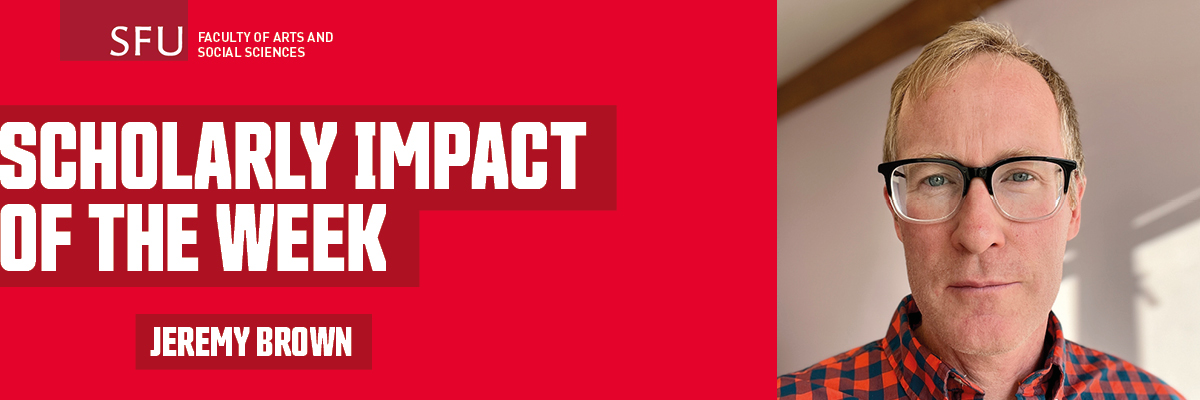
This year marks the 33rd anniversary of the public demonstrations in Tiananmen Square and subsequent massacre in Beijing on June 4, 1989. The student-led protests saw over a million people gather in the square, until the government declared martial law and more than 180,000 army troops moved in. Thousands of civilians—some of them students—were killed.
The events leading up to and culminating in the Tiananmen Square protests and crackdowns are often referred to through a western-centric lens as China’s Democracy Movement, with an emphasis on whether the violent suppression of protestors was necessary. At the time, the Chinese government deemed the peaceful gatherings turmoil and it still forbids discussing or commemorating June 4—extreme censorship that makes it even more difficult to gain insights into this moment in time.
Simon Fraser University (SFU) History Professor Jeremy Brown recognizes the complexities of this time period and wants to change the way China’s history is understood. Brown is a historian of modern China, an award-winning professor and Chair of SFU’s History department. His book, June Fourth: The Tiananmen Protests and Beijing Massacre of 1989, sheds new light on what happened in 1989 and why.
We talked with Professor Brown about his book.
How did you go about gathering new details around a contested event three decades ago? Were people willing to talk about it?
Many rich sources have become available outside of China in recent years. These include memoirs by top Chinese officials and protest leaders, military after-action reports and the Tiananmen Mothers’ interviews with victims’ families. I even found a file of post-protest confessions by workers. People who lived through 1989 and who now live outside China were eager to talk to me about something that affected them so dramatically. I was also buoyed by support from my friends in China, who consistently told me to keep writing, that the book was important and necessary, and who found ways to give me a thumbs-up after the book was published.
Based on your understanding of modern Chinese history, what were the 1989 protests about?
The changes of the 1980s gave people in China lots to be happy about, including economic opportunities and political freedoms, which raised their hopes for further change—but there were also new sources of frustration and anger, such as traumas associated with the one-child policy, periodic political crackdowns and the halting pace of reforms. When the protests erupted in April 1989, they were about transparency, the right to establish autonomous student organizations and worker unions, freedom of the press and opposing corruption. Protesters were not asking for a Western-style democracy of one person, one vote—they were asking for a better, more open Chinese system.
Many historical accounts of June 4, 1989 focus on Beijing and the protests within the city. You mentioned a gap in scholarly work about what was happening outside of Beijing that spring. What was going on in the rest of China?
In March 1989, martial law and a violent crackdown on protesters in Lhasa, Tibet, foreshadowed what would happen in Beijing a few months later, but few people in China’s capital noticed this or made the connection. Starting in April, protesters in provincial cities broke into and ransacked government compounds. They also made different demands and expressed distinct concerns. For example, demonstrators in Shanxi Province were angry that Communist Party officials had built a luxurious office building there. Muslim demonstrators in Kunming, Yinchuan, and Urumchi protested the publication of a book that insulted their religion.
Your book talks about how the protests did not need to end violently. Can you elaborate?
Mobilizing tens of thousands of army troops wielding machine guns and driving tanks to suppress a non-violent civilian protest that was already losing steam was a failure of governance and a failure of imagination. In the book, I discuss various alternative paths that could have avoided bloodshed. These include using non-lethal methods to clear Tiananmen Square, like what happened during a previous protest in April 1976—or simply waiting out the protesters, whose numbers were dwindling and many of whom had already left Tiananmen Square by June 1989. Beyond these strategic decisions, General Secretary Zhao Ziyang did try to use dialogue to find a political solution, but he was outmaneuvered and removed from office by other leaders, which cut off this alternative path.
What other new perspectives does the book offer? What else is missing from the historical account?
By shifting focus away from students in Beijing, I am trying to make two big points: first, the protests were more than a student movement. Millions of ordinary citizens took part and gave the protests a new momentum beyond what the students could have achieved on their own. Second, student leaders’ decision-making—flawed as it was—did not cause the massacre. Top Communist Party leaders perpetrated the massacre, the victims of which were mostly not students, but were ordinary people who either wanted to protect the students, were curious to see what was happening, or were simply innocent bystanders caught up in the reckless gunfire.
For more on the Tiananmen Protests and Beijing Massacre of 1989, and Brown’s book, check out Harvard’s Modern China Lecture Series, the Wilson Center book talk, and his interview with The China Digital Times.
SFU's Scholarly Impact of the Week series does not reflect the opinions or viewpoints of the university, but those of the scholars. The timing of articles in the series is chosen weeks or months in advance, based on a published set of criteria. Any correspondence with university or world events at the time of publication is purely coincidental.
For more information, please see SFU's Code of Faculty Ethics and Responsibilities and the statement on academic freedom.